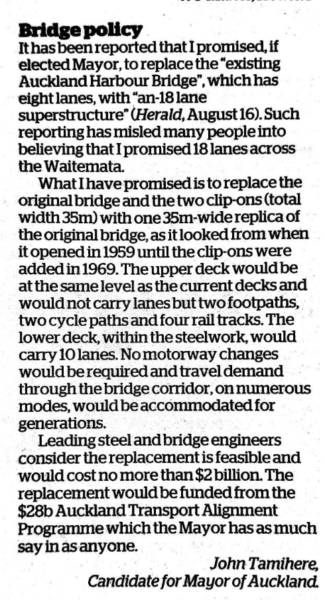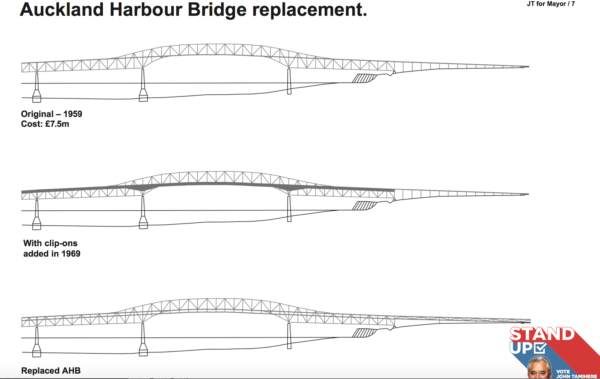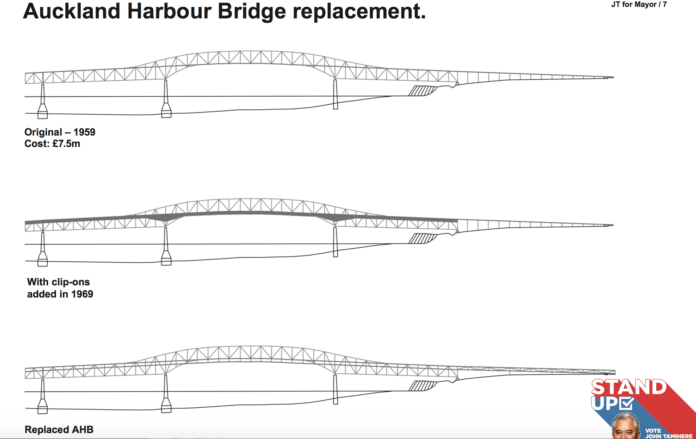
John Tamihere’s proposed harbour bridge replacement has been described in the media as having 18 lanes because it has 4 foot and cycle paths, 4 rail tracks and 10 lanes. We believe that even the Mayor was misled by such reporting into thinking and saying that John’s proposal is to build an 18 lane bridge. That is the same as thinking and saying that Queen Street has six lanes because it has two footpaths and four lanes.
16 August 2019 Press Release Mayor Phil Goff:
The 18 lane harbour bridge that John Tamihere is proposing is going to cost over $10 billion to build.
Widening the motorway at either end to match the 18 lanes would see massive demolition of buildings and destruction of homes and neighbourhoods. This will cost further billions of dollars that Auckland doesn’t have and the Government won’t pay for.
This is total fantasy stuff and fundamentally dishonest to promise.”
There have been numerous similar statements in media reports from journalists who we believe were similarly misled. It seems no journalist asked Mr Goff to back up his $10 billion claim or at least ask both Goff and us to justify our costings.
We request that in the future you refer to the bridge as a 10 lane bridge.
Please see at right, and to follow, for your information: the letter from John published in today’s New Zealand Herald, an email from NewZealand’s leading structural steel engineer confirming that the bridge proposal is feasible, images of the proposal, the costing of the bridge proposal on page 1 of the Harbour Bridge Q&A from our policy page jtformayor.co.nz/pages/policy, and the details of a similar length bridge replacement carried out in the United States in 2014.
New Harbour Crossing Q&A
Is it really possible to replace the current Auckland Harbour Bridge (AHB) ?
Yes. The Milton-Madison Bridge between Ohio and Kentucky was built in 1929 as a 6 m wide bridge, just wide enough for 2 lanes, – the same length as the Auckland Harbour Bridge. It was replaced in 2014 by a new 13.5 m wide bridge with two lanes, two cycle / stopping lanes and a footpath. The method is scalable and our engineering advice is that it is entirely possible, with conventional engineering techniques, to replace the current 4 lane central bridge, and the two 2 lane clip-ons (total width 35 metres) with one, 10 lane, 35 metre wide, bridge with a second level below the level of the current deck level.
Who says so?
University of Auckland Associate Professor Charles Clifton has been giving advice on the proposal since 2014. His opinion is that the plan is feasible. Dr Clifton is New Zealand’s leading expert on steel construction. Please see email from Dr Clifton at the end of this Q&A. Other bridge engineers agree with Dr Clifton but work for companies that do not make public comments on proposed major projects.
Will the new bridge have 18 lanes?
No. The new AHB with have 10 lanes, 4 foot and cycle paths and 4 rail tracks.
What will the bridge replacement cost?
The Milton-Madison bridge replacement project replaced a 6 metre wide, 1,000 metre long bridge deck with a 13.5 metre wide bridge deck. The cost was $103.7m in 2014; approx. NZ$ 200 million in 2019 dollars which is approximately NZ$14,000 per square metre (sqm) of bridge deck. The AHB replacement will create 70,000 sqm of deck @ $14,000 per sqm amounts to a total of $980 million. To that we have added 50%, $500 million, to allow for increases in costs over the time of the build and increased costs for the project being in New Zealand; total $1.5 billion. We have also added a 33% contingency, a further $500 million, bringing the total cost to not more than $2 billion. This is a conservative costing. Bridges are usually costed in New Zealand at around $5,000 per sqm of deck including the cost of foundations and piers.
Has NZTA seen the proposal?
The Minister of Transport, Phil Twyford, was provided with an outline of the proposal in November 2017. At the Minister’s suggestion NZTA staff were met with during 2018 and briefed on the proposal.
Is that good value for money?
Yes. Something has to be done about the AHB, and done before 2030 so the decision has to be made now. Pedestrian and cycle ways are needed now. Projections are that the clip-ons may not be able to take heavy trucks after 2030 and the Northern Busway may be at full capacity by 2030. The only plan in place is to consider building a tunnel in the 2040s for who knows what cost? The AHB replacement can be completed in six years for not more than $ 2 billion as part of the $28 billion Auckland Transport Alignment Program which the Mayor of Auckland has as much say in as anyone. It will be good value for money as any transport project in Auckland.
Surely it will disrupt road traffic.
There will be planned closures – likely between off peak times, like Christmas and New Year whenever possible. The Newmarket Viaduct was replaced with traffic disruption, including closing SH1. There was disruption; the disruption was worth it.
How many major closures will there be?
Two major closures, for only 3 to 5 days over the Christmas New Year lull. The first closure will be to move the approaches to the new bridge in its temporary location. The second closure will be to move the bridge to its permanent location on the existing piers.
Have NZTA assessed the possibility of replacing the AHB bridge?
NZTA have not considered replacing the AHB bridge. It is not in the long list of 160 options considered in a 2008 NZTA report.
The Milton-Madison example you have given us is only a four lane single level bridge. Is 10 lanes on two levels really possible?
These days’ even buildings can be moved if needed. For example the fragile Bird Cage pub was moved 40 metres, and then moved the same 40 metres back again. The fragile Cornish Pumphouse in Waihi was moved 300 metres. The new AHB bridge will not be fragile; it will be designed and built so that, once the original piers are ready for it, it can readily be moved the about 40 metres to its permanent location on the original piers.
Will the bridge replacement process be safe?
Bridge replacement is a common process and safe methods are well practised. Developments in computing and in sensors mean that every aspect of the bridge can be monitored in real time and adjusted as necessary.
Why not build a new bridge?
A new bridge would cost at least $4 billion at minimum and take a decade to build. A second harbour bridge would adversely affect the aesthetics of the Waitemata Harbour and of the existing bridge. Having two harbour bridges would create complicated road interchanges on either side of the bridge which would have adverse effects on the environment including the likely need for significant sea reclamation which is contrary to the Auckland Unitary Plan. Replacing the bridge will cost no more than $2 billion, can be completed in 6 years and will have negligible adverse effects.
Why not make the replacement look different to the 1959 original?
The 1959 original is a mid-century classic and an icon of Auckland. There is no need to change the appearance of the bridge. There is only the need to make the bridge fit for purpose for the 21stcentury and beyond.
Why not replace the clip-ons?
Auckland needs one fit for purpose bridge that provides all the connectivity that is possible on the St Mary’s Bay to Northcote alignment. Replacing the clip-ons would provide less capacity, may cost more and take longer to build and would make it difficult, if not impossible, to include rail and would retain the current divided carriageways which are not as safe as undivided carriageways.
Why 4 rail lanes?
Futureproofing. Initially only two lines will be needed. However if there is a desire to provide street based services to Northcote and Birkenhead, they would be of such a frequency as to interfere with the very frequent tram-trains heading to and from Albany and beyond.
Will houses on Stokes Point have to be compulsorily acquired?
Some residential land will be required for the replacement project. NZTA avoids compulsory acquisition and is experienced in purchasing private properties that are required for national transport infrastructure projects. Once the project is complete any land acquired for the project may stay in public ownership.
Won’t the bridge replacement be unbearably disruptive for the residents of Northcote Point?
Everything will be done to minimise disruption.
Where will pedestrians and cyclists enter and exit the bridge on Northcote Point?
NZTA is currently consulting on this. One option I am interested to consider is if the area around the old Auckland Harbour Bridge Trust Board building and toll booths can be redeveloped to maximise public space and be the place where cyclists and pedestrian enter and exit the AHB on the North Shore.
How would rail, pedestrian and cycle ways connect to the ground on St Marys Bay and in Northcote?
Attractive on and off ramps will be designed for rail, cycle paths and footpaths. I am looking at the old toll both area as the main junction point on the Northcote side, and there are a number of options on the St Mary’s Bay side. The eastern and western cycle and pedestrian ways will likely connect to eastern and western sides of the bridge at both ends of the bridge.
How will the bridge replacement effect Skypath?
With two cycleways and two walkways on the upper level of the new bridge Skypath will not be needed and will not be built.
Will the new AHB bridge have the same sized footprint as the existing bridge in St Mary’s Bay and on Stokes Point?
Yes. The road approach to and egress from the AHB is already wide enough to accommodate 10 lanes of traffic, so the new bridge will not require wider approaches or egresses.
Will the motorways to the north and south of the bridge have to be widened?
No. At the moment there are 10 motorway lanes leading to the south side of the AHB and 10 lanes leading to the north of the AHB but only 8 lanes on the AHB itself necessitating the use of the movable median strip and tidal flow traffic control. With the new 10 lane bridge in place the SH1 to the south of the AHB, over the AHB and to the north of the AHB will all be 10 lanes.
How quickly can the new AHB bridge be in place?
We are committed to completing the project by 2025 – 6 years.
Will it be difficult to get resource consent for such a large project?
Not very. Whilst it is a big project, because we are replacing like with like there will be minimal adverse effects on the environment apart from effects during the construction phase. Careful planning will be needed for the construction, but the planning will be done right, and that will make it relatively straightforward to get resource consent.
What will happen to the movable barrier and the elephant houses?
They will be removed.
Is there a plan to build a tunnel?
There is a plan – if the money can be found at the time. Central government and Council’s current position on the tunnel is: “Current investigation work into an additional Waitemata Harbour Crossing needs to be completed to provide more certainty about the optimal timing, modal mix, configuration and operation of the crossing. Consistent with earlier ATAP work construction is not anticipated to commence until at least the late 2030s.” The estimate of the cost of the tunnel is $ 4 billion plus. With the very high rate of major infrastructure construction inflation by the late 2030s the currently proposed tunnel may be unaffordable.
Would replacing the bridge rule out a future tunnel?
If future generations decide to build a tunnel, having a fit for purpose AHB from 2025 won’t hinder any such plan. With a fit for purpose AHB in place possibilities such as a rail tunnel between the eastern CBD and Devonport can be explored.
Why are you talking about the AHB when it is NZTA’s responsibility?
Under the Local Government (Auckland Council) Act 2009 the Mayor of Auckland’s role is to “articulate and promote a vision for Auckland; and provide leadership for the purpose of achieving objectives that will contribute to that vision.” If elected I will have the mandate to negotiate what central government agencies do in Auckland, including that NZTA replaces the AHB bridge because Auckland and New Zealand needs it.
Who will build it?
The contract will be tendered on the international market and is likely to attract great interest from experienced engineering and construction firms.







This is awesome! Since the closing of nominations for Mayor last Friday. The media and social media have gone nuts with everything that JT has thrown out there! Suckers!! Driving the rednecks crazy.
I live in Milton, Ky., and covered much of the bridge-replacement project as a local journalist. This sounds like an exciting project. There were a ton of naysayers here about the project – that it couldn’t possibly work. All along I said that, of course it would work, because no construction company wants to build the bridge that fails and falls into the river. It was amazing to watch the entire process as it moved on day to day.
Sounds like a good idea to me.
JT is no fool, and has a lot more intelligence and common sense cf to Phil Goff IMHO
If it works overseas in the USA and the engineering is sound there is no reason why it will not work here in New Zealand.
Comments are closed.